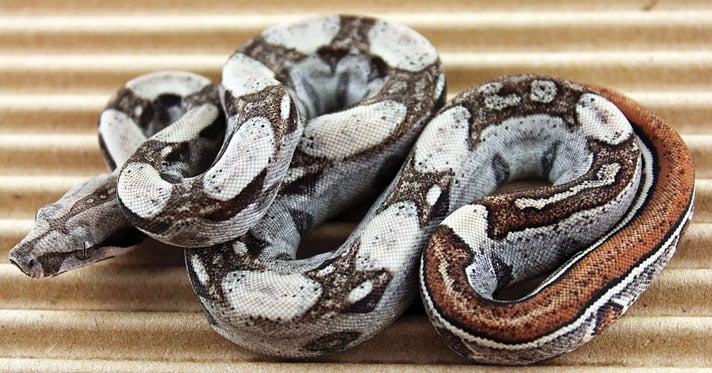This article will focus on how to keep B. c. imperator.
I have kept and bred many boa constrictors for more than 15 years, and although I don’t consider myself a “Boa Whisperer,” I have learned much that has helped me to keep my boas happy and healthy. In writing this article, I hope to demonstrate that boa constrictors can make wonderful pets, and by employing the proper care and attention as described here, they will be happy and healthy for you, too.
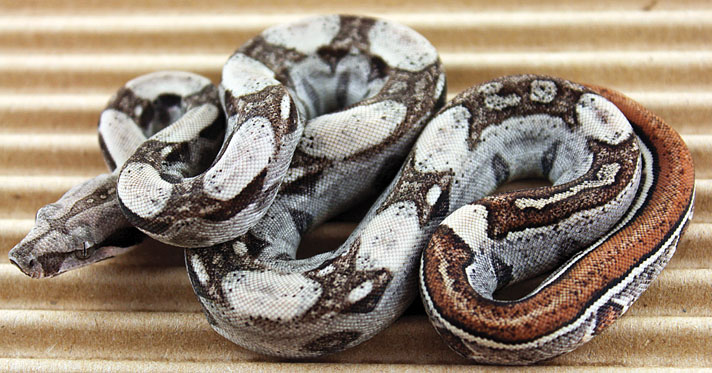
kevin blumenthal
The first thing you’ll want to do if you’re considering a pet boa constrictor is to make sure it is legal to own one where you live.
Though there are many types of boas—various subspecies, island and other locale types, etc.—two are the most commonly available in the pet trade. The first is Boa constrictor constrictor, which is considered to be the “true” red-tailed boa because specimens usually have very red tails. In the wild, these boas can be found in Guyana, Suriname, Brazil, and Peru.
The second is the more common subspecies, B. c. imperator. Its natural range is primarily in Colombia, but it can be found in every South American country, throughout Central America, Mexico, and various tropical islands.
Unfortunately, many pet stores incorrectly refer to B. c. imperator as a “red-tail boa”, which causes confusion between it and B. c. constrictor (the reason the latter is sometimes referred to as the “true” red-tail).
This article will focus on how to keep B. c. imperator. When the words “boa” or “boa constrictor” are mentioned here, they represent B. c. imperator.
Is The Boa Constrictor The Right Snake For You?
The first thing you’ll want to do if you’re considering a pet boa constrictor is to make sure it is legal to own one where you live. Unfortunately, some city ordinances do not allow boa constrictors to be kept as pets.
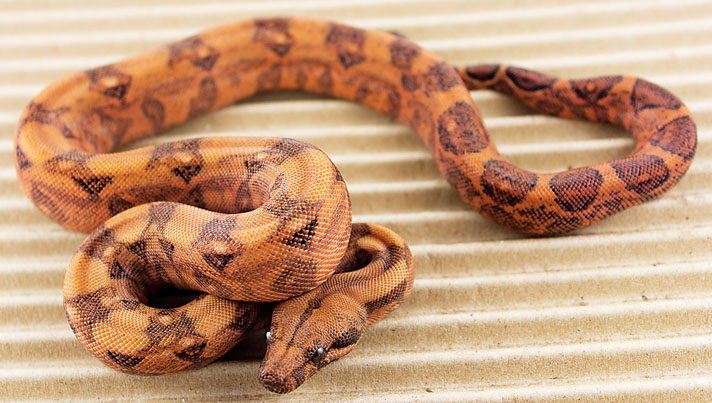
kevin blumenthal
Blood boa. Boas can be terrific, safe-to-keep, low-maintenance pets. They are often active and alert, and usually tolerate handling well.
Captive boa constrictors can live in excess of 20 years with proper care and husbandry. Properly fed adult females, on average, reach 6 to 7 feet within three to five years (with some reaching up to 9 feet). Adult males typically reach 4 to 6 feet within the same amount of time. Boas actually never stop growing; their growth rate just slows down dramatically once they reach adulthood at three to five years.
Boas can be terrific, safe-to-keep, low-maintenance pets. They are often active and alert, and usually tolerate handling well. They can sometimes hiss or strike, especially when they are young, but this is more of a defensive stance if they are not used to being handled or are simply not in the mood. A bite from a small boa feels like a pin prick—it’s more startling than actually painful. With regular handling, though, most boas become tame and stop being so defensive.
The Best Enclosure For Your Boa Constrictor
Once you decide to own a boa constrictor, the first thing you should do is buy or build a proper enclosure, and you will want to have it set up for at least 24 hours, so proper heat and humidity is established, before placing your new boa inside it. The enclosure needs to be functional and efficient at maintaining the proper temperature and humidity at all times. Having a stressed-out boa, or one that is sick or has problems shedding or eating—all things that could happen if a boa is not kept in a proper enclosure—will shorten its lifespan and make for an unpleasant experience for both the boa and for you.
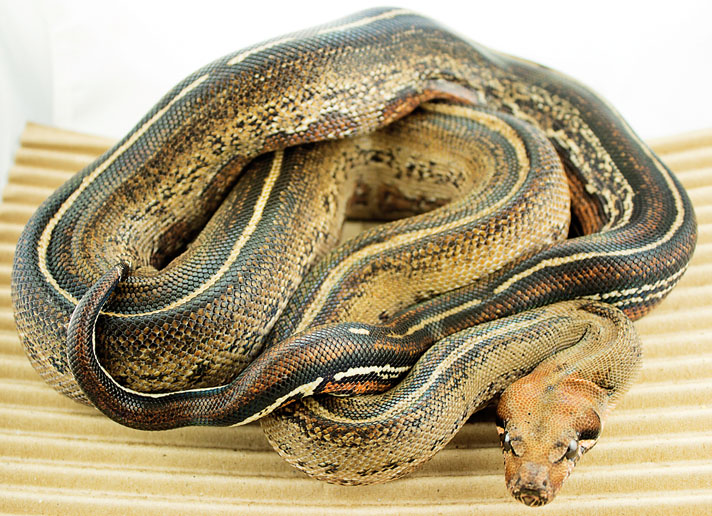
kevin blumenthal
Leopard boa. I do not recommend keeping a boa in an all-glass enclosure such as an aquarium. It is tough for a glass enclosure to maintain the proper humidity a boa needs.
I do not recommend keeping a boa in an all-glass enclosure such as an aquarium. If you use an under-tank heating pad with such an enclosure, you run the risk of the glass cracking, or, because glass is a heat conductor, having a portion of the glass heat up to the point that it might burn your boa if it comes in direct contract with it. It is also tough for a glass enclosure to maintain the proper humidity a boa needs. Aquariums may allow heat and humidity to escape, especially if a screened top is used, as is common with this type of enclosure. With such a set up, you would create a very drafty and less humid environment for your pet, which could lead to health problems. Last but not least, boas are more prone to escape from a glass aquarium with a screen top rather than other enclosures that are more secure. A proper boa constrictor enclosure will not only maintain heat and humidity, it will have a secure door (preferably one that can lock) to prevent escape.
There are companies that specialize in boa caging and that usually provide proper heating via under-cage heating or radiant heat panels on the inside top of the cage (a few of these companies are Cages By Design, Proline Cages, Boaphile Plastics, Vision Products, and Animal Plastics).
An easy formula to determine proper enclosure size is its width plus length should be equal to or greater than the length of your boa. Of course, the larger the enclosure you can provide your boa, the better. Because young boas grow fast, you don’t want to purchase an enclosure that may fit a young snake today, but be too small in a year or two. It is a myth that boas will grow only as large as the cage in which they are kept. They will continue to grow despite the size of their enclosure, so plan to give them room to roam now and in the future. This means that even if you plan to purchase a baby boa, get an adult-sized enclosure for it to grow into.
For example, if you bought a baby female boa, which may reach 6 feet as an adult, you could provide a 4-foot-long by 2-foot-wide enclosure. Even though a baby boa is 12 to 18 inches at birth, and it will be dwarfed in an enclosure this size for awhile, within three years it should be just right (and once again, bigger would be even better).
To feel secure, young boas like to have a place to hide. If you are keeping a baby or yearling in an adult-sized enclosure, have at least a couple hides in the enclosure, preferably one at each end. A hide can be anything from a shoebox with a hole cut into it to a cat litter box turned upside down with a hole cut in one end, or more decorative hides, resembling caves or other natural formations, that can be found at pet stores. As boas mature, hides become less necessary as the snakes become comfortable in their enclosures.
Boas will climb if provided branches, shelves, secured dowels, etc., in the enclosure, but this is not required, and so height is not as important as floor dimensions. A common height for boa enclosures is 12 to 24 inches. Keep in mind, it can be tougher to maintain proper temperatures in taller enclosures.
For substrate, you can use newspaper, corrugated cardboard, or craft paper, which absorbs urates well, but isn’t the most decorative. Corrugated cardboard gives your boa something to grab onto when it moves around the cage and will help with muscle tone. Another popular choice is aspen or cypress shavings. Both will give your boa a place to burrow/hide, and they hold humidity well, but with them it can be tougher to discover urates and feces, so be sure to change the substrate frequently. Check the enclosure every day for urates and feces, and remove any immediately, as the high heat and humidity in a boa enclosure can form bacteria quickly. I recommend using Nolvasan mixed with water to clean the enclosure, as it is used by veterinarians to clean their examining rooms.
You can decorate a boa’s cage with backdrops, shelves, plastic vines, etc., or you can even create a naturalistic environment with live plants, waterfalls, misters, etc. However, I don’t recommend such things if they prevent you from being able to maintain cleanliness. Such setups can look very nice, but be aware that they will require more maintenance and upkeep to keep them clean and bacteria-free.
Optimal Temperatures For Boa Constrictors
Boa constrictors do not do well in cold temperatures, and they can get a respiratory infection if they’re kept at temps below 70 degrees Fahrenheit. Boa enclosure temperatures should be between 80 and 92 degrees—80 degrees on the cool end, and 90 to 92 degrees on the warm end, where a heating element (such as an under-cage heater, heat tape, ceramic heat emitter, basking light, etc.) should be placed, if these are not already built into the enclosure. This temperature range will produce a thermal gradient, along which your boa will position itself.
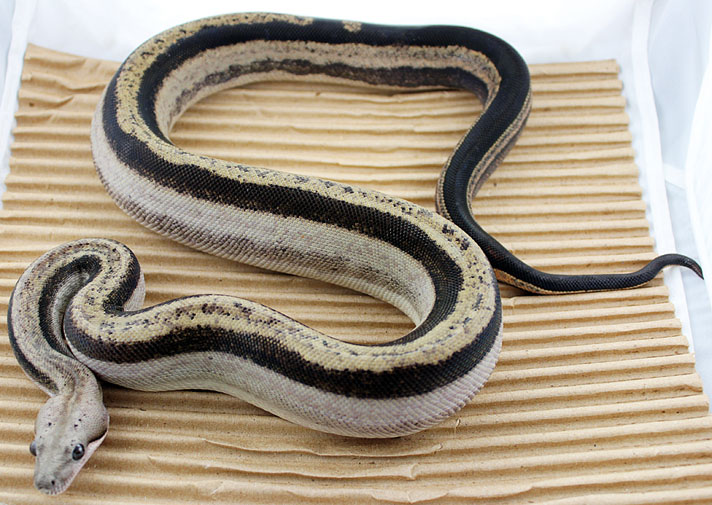
kevin blumenthal
Humidity in the enclosure should be maintained between 60 and 75 percent.
Typically, a boa will remain in the warm end of the enclosure when digesting a meal. If it begins to feel too warm, it will move toward the cooler end. Do not use an electric “hot rock” to provide heat, as these might get hot enough to burn a boa’s skin.
Humidity in the enclosure should be maintained between 60 and 75 percent. Spray the substrate with water to help raise humidity, if needed, but be aware that a boa laying on wet substrate for too long can lead to scale rot. And naturally, avoid locating the enclosure in a drafty or cool location in your house.
To properly control the temperature in your enclosure, it is very important to have a good-quality thermostat, placing the temperature probe on the warm end of the enclosure. Some of the better thermostats I’ve used are from Herpstat, Vivarium Electronics and HydroFarm.
Keep a thermometer at one end inside the enclosure. Acurite makes one that also has a humidity gauge, so you can check the humidity in the enclosure, as well as an “outdoor” cable that will allow you to measure the temperature at the other end of the enclosure, along with an app that can monitor the temps remotely. You can also monitor your temps and humidity remotely with a Reptile Guardian sensor. I also recommend using a temp gun to measure the temperature by “shooting” a spot in the enclosure to determine the temperature at that precise spot.
Having a UPS (Uninterruptible Power Supply) hooked up to your enclosure will keep it heated in case of power outage. The larger the UPS, the longer your enclosure will stay heated during power loss. If you do have a power outage, at the minimum, you can use multiple 24-hour heat packs under the enclosure to keep it warm. Never let your boa come in contact with them, though, as they might burn your pet.
Water For Boa Constrictors
Tap water is usually fine for boas, or filtered water. Do not give them distilled water. The water bowl should be one your boa will not be able to tip over, and large enough for it to soak in. Boas will soak in their water bowls to cool/hydrate themselves, and also to aid in shedding. Place it in the cool end of the enclosure, and check it every day, as boas like to use the water bowl to go to the bathroom. Give your boa fresh water at least twice a week.
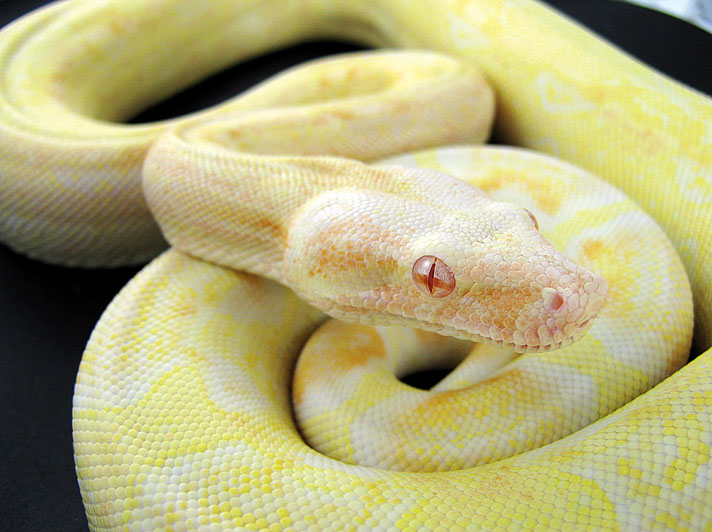
kevin blumenthal
Your boa should not consistently soak in its water bowl unless it is getting ready to shed.
Your boa should not consistently soak in its water bowl unless it is getting ready to shed. If it does, this may indicate that it is stressed or insecure (provide more hiding spots in the cage), or it may have mites. It can also be a sign that proper humidity levels are not being maintained in the enclosure. An additional large bowl of water can be placed on the warm end of the cage to help raise humidity, if needed.
Use Dawn dish soap when cleaning water bowls, and make sure they are thoroughly rinsed; you don’t want to see any sign of soap film in the fresh water. Also, don’t wash boa water bowls in the kitchen sink, to avoid any potential Salmonella issues.
As your boa constrictor grows, it will shed its skin—more frequently when it is young and less frequently as an adult. Prior to shedding, a boa’s eyes and skin color will appear cloudy for a couple days, then they’ll clear up for about five days, and then it will shed its skin. During this approximately week-long process, if the enclosure is not at the proper humidity, spray your boa with a fine mist of warm water a couple times a day, or mist the enclosure to increase humidity. You could also soak your boa in tepid shallow water in a Rubbermaid or similar lidded container, or in a bathtub (under supervision) for 30 minutes once a day until it sheds. The goal is to help your boa shed its skin in one piece.
Do not handle your boa for extended periods of time during “shed week.” Once it has shed, examine your boa closely to see if there are any remaining pieces of old skin, including over the eyes. If there are any stuck pieces left behind, use a warm, wet washcloth to gently remove them, rubbing toward the tail, or soak your boa in some warm water to help remove the pieces. They may also be shed off the next time your boa sheds.
If your boa sheds its skin in multiple pieces, it is either a sign that your enclosure needs higher humidity (most likely), or there may be something wrong internally with your boa. If you adjust the humidity and the problem persists, a vet visit is in order to run some tests.
Choosing Your Boa
So you have your boa enclosure set up, and now’s the fun part—getting your new boa! It is important to only have one boa per enclosure. Boas in the wild are solitary, and problems can result if housing more than one boa in an enclosure.
Check references for the person or pet store you are buying from, and, if possible, check the boa’s enclosure for cleanliness and proper heat/humidity. Examine the boa to ensure it is in good shape, with good body tone and no kinks. The skin should be free from any abrasions or wounds of any kind, without old pieces of shed skin stuck to it. Examine the mouth area; it should be normal and not exhibiting any swelling, which could be a sign of mouth rot. The boa should flick its tongue frequently, like to move and wrap, and it shouldn’t mind being held.
Above all, make sure the boa does not have mites. Snake mites are very small, black, and attach themselves to a snake like tiny ticks. Examine the boa closely, and hold it at an angle that allows you to see beneath its belly scales, where mites may congregate. They are very harmful to a snake, and can eventually lead to its death if not thoroughly eradicated from both the snake and its enclosure. They can be very tough to remove from the enclosure, too, as they reproduce quickly and are very hardy.
Try to buy a captive-born boa. With the sheer numbers available today, you should have no problem finding one. Captive-born boas may be more expensive, but they are usually healthier, eating well, and they typically have much better dispositions than imported, wild-caught boas, which are often stressed and may come with various health issues, such as internal parasites, etc.
Once you have your new boa, take it to a veterinarian who specializes in reptiles (checking to see if there is one near you is also something you may want to do prior to getting your new pet) for a checkup. A fecal test for internal parasites is recommended at this time.
Handling Your Boa
Handling pet boa constrictors often will help keep them tame, but don’t handle them when they’re digesting a meal or when they’re in shed. Also, do not let boas wrap completely around the front of your neck. A boa will not usually try to strangle you, but if it is startled or feels insecure, it might tighten its muscles around your neck, causing you to lose consciousness, as boas are very strong animals.
Keep other pets away when you are handling your boa, especially if they are rodents such as gerbils and hamsters, or rabbits, guinea pigs, etc., as these all are potential meals. While the chance that your boa might strike at another pet may be slim, why take that chance? Also, be careful when handling boas around small children, or letting small children hold them.
Boas should be properly supported during handling at all times. Place one hand under the body up near their head, and the other along the last two-thirds of the snake’s length. Boa constrictors like to feel secure, too, so they may loosely wrap their body around your arm, wrist, or waist for support. They will not squeeze tightly unless they are startled or think they are falling.
Always be sure to wash your hands thoroughly after handling your boa or cleaning its cage.
Is Lighting Necessary For Boa Constrictors?
Lighting within the boa enclosure is nice to have so you can view your boa at night. While boas will be active during the day, they usually are much more active at night. Indirect ambient lighting is fine, but make sure the enclosure does not receive any direct sunlight, as this can heat the enclosure beyond the optimal temperature range. Boas do not need any kind of UVA or UVB lighting, as they receive all the vitamins and nutrients they need from their meals.
Feeding Your Boa Constrictor
The age, sex and size of your boa will determine how frequently to feed it. Here is a general guideline:
- Newborn to 1 year old: every seven to 10 days
- 1- to 2 years old: every two weeks
- 2- to 3-year-old males: every three weeks/females, every two weeks
- 3-year-old and older males: every three to four weeks/females, two to three weeks
The above schedule isn’t set in stone, and lengthening and varying the time between feedings may actually be beneficial for the long-term health of your boa. Much like humans, some boas grow faster and larger with normal-sized feedings than others, so you might need to adjust the frequency of feedings if your boa is too thin. The important thing is not to overfeed (“power feed”) your boa. Feeding it too much food or too often will make it fat and unhealthy, shortening its life.
A normal meal is one that is approximately the same size as the largest part of your boa. Just after your boa has eaten, there should be a slight lump in its body. If there is a large lump, on which the scales are greatly separated, then the meal was too large, which could result in your boa regurgitating its meal. A “regurge” is very hard on a boa, and once it has regurged once, it might continue to do so after every meal, which can lead to death. So be sure you’re feeding appropriately sized items, and feed only one item at a time.
It will take approximately 48 hours for your boa to digest its meal, and about a week or two later, it should defecate. If it has eaten two or three meals without defecating, wait before feeding another meal. To help the defecation process along, you can exercise your boa by handling it and letting it move around, but to avoid regurgitation, don’t do this until 48 hours after its last meal. You can also soak a potentially constipated boa in shallow, lukewarm water in a Rubbermaid container with a lid for 30 minutes.
Meal options are mice, rats, rabbits, quail, or even blanched chicken. Mice usually are used when a boa is young, and I recommend converting to rats as soon as possible. Larger adult boas can be offered a large or jumbo-sized rat, or an occasional rabbit. Such prey items contain the proper nutrients for your boa, and no additional vitamins or supplements are needed.
Prey items should be either frozen/thawed or freshly killed, as live prey may bite your boa. Boas have poorly developed pain receptors, so they may not realize they are being hurt until it is too late. Also, live prey items may not have been kept in sanitary conditions, or they might have internal parasites. Quality frozen/thawed prey can be found at reptile specialty shops, shows and various online vendors.
Thaw frozen prey items in water in a Tupperware container (one you will never use again for human use). Start with cold water, then after an hour, replace with warm water, and 20 minutes later, run hot water over the prey item for a minute to warm it up to a temperature that the boa will sense (they find prey using heat signatures). Larger rats and rabbits may take longer to properly thaw during this process. Newborn boas could be fed live prey, such as pinky or hopper mice—these are too small to inflict any damage—until they are used to eating a meal.
When feeding your boa, use hemostats that are at least 12 inches long; longer is better, especially as your boa gets larger. A boa will usually constrict its prey even if it’s already dead, and I recommend hemostats because your boa could mistake the body heat in your hand for prey. Having the prey item further away on the end of hemostats will prevent an accidental feeding-response bite. Boas have a heightened sense of awareness immediately prior to being fed—they definitely know when it’s feeding time!
I don’t believe in moving boas to another enclosure to feed them, as is sometimes recommended. The last thing you want to do after a boa has been fed is move it, as it may regurge its meal.
Boa Constrictor Morphs
Boa morphs are unusually colored or patterned boas, and they may result in a number of ways. They may be discovered in the wild and brought into the pet trade, created accidentally when someone breeds a pair of boas, or created purposefully when a breeder breeds boas with known morph genes together. They may look different than a normal boa, but their care requirements are the same.
A few examples of some boa morphs are:
- Albino (lacking melanin; various types)
- Anery (short for anerythristic; lacking red pigment)
- Hypo (short for hypomelanistic; less black or brown than a normal boa)
- Jungle (aberrant pattern, broken head spear, increased color)
- Leopard (unique pattern and color)
- Motley (unique pattern)
- Blood (increased red)
- IMG (Increased Melanine Gene—the boa gets darker as it ages)
There are also “combo gene” morphs in which more than one gene is in a single boa and creates a totally different look. A few examples are:
- Snow (combination of Albino and Anery genes)
- Moonglow/Snowglow (combination of Albino, Anery and Hypo genes)
- Ghost (combination of Anery and Hypo genes)
- Jungle Motley (combination of Jungle and Motley genes)
- Sunglow (combination of Albino and Hypo genes)
- Eclipse (combination of Colombian Motley and Leopard genes)
Not only are more boa morphs being created or discovered every year, new combinations of genes are being created, as well. When you’re ready to buy your boa, check out all the different morphs that are currently available—you’re bound to find one with that extra appeal you seek!
Boa constrictors make great pets thanks to their normally calm demeanor, relatively low maintenance and easy care. They are also active, available in a large variety of types, colors and sizes. They’re especially good pets, as are other reptiles, for people who are allergic to pet dander.
Hopefully, this article will prepare you to keep a pet boa for many years to come. With some commitment and proper care, you will enjoy having a boa as much as it will enjoy having you as its owner.
Kevin Blumenthal has been taking care of his many boa constrictors for more than 15 years, and has been successfully breeding boas for more than a decade. He has created some “world’s first” boa morphs, and can be contacted through either his website at blumenboas.com, or via his Facebook business page.

